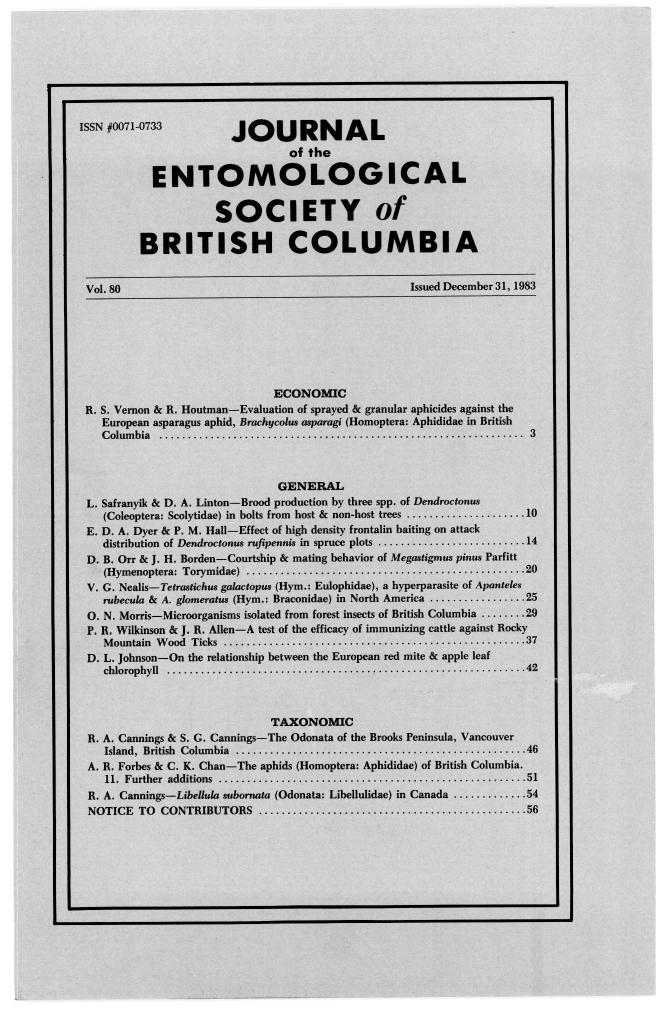Courtship and mating behavior of <i>Megastigmus pinus</i> Parfitt (Hymenoptera: Torymidae)
Abstract
The courtship and mating behavior of <i>Megastigmus pinus</i> Parfitt was observed in insect cages and under a dissecting microscope in petri dishes. Courtship had 6 components: a premounting rocking performance by the male; mounting by the male to a dorsal riding position on the female; antennation and abdominal and wing movement by the male; a series of forward lurches by the male; signaling of receptivity by the female, and subsequent movement of the male to position for copulation. The average durations of mounting and copulation were 6.76 min and 23.5 sec, respectively. Short courtship and copulation times may reduce the risk of predation.References
Assem, J. Van Den. 1974. Male courtship patterns and female receptivity signals of Pteromalinae. Neth. J. Zool. 24:253-278.
Assem, J. Van Den and G.D.E. Povel. 1973. Courtship behaviour of some Muscidifurax species (Hym., Pteromalidae): a possible example of a recently evolved ethological isolating mechanism. Neth. J. Zool. 23:465-487
Crane, J. 1957. Basic patterns of display in fiddler crabs (Ocypodidae, Genus Uca). Zoologica 42:69-82.
Crane, J. 1966. Combat. display and ritualism in fiddler crabs. (Ocypodidae, Genus Uca). Phil. Trans. Roy. Soc. London B 251:459-472.
Engelmann, F. 1968. The physiology of insect reproduction. Pergamon Press, New York.
Ferkovich, S.M., S.G. Wellso, and W.T. Wilson. 1967. Mating behavior of the bigheaded grasshopper, Aulocara elliotti (Orthoptera: Acrididae) under caged conditions in the greenhouse and outdoors. Ann. Entomol. Soc. Amer. 60:972-975.
Fockler, C.E. and J.H. Borden. 1972. Sexual behavior and seasonal mating activity of Trypodendron lineatum (Coleoptera: Scolytidae) Can. Entomol. 104:1841-1853.
Furniss, R.L. and V.M. Carolin. 1977. Western forest insects. USDA, For. Serv. Misc. Publ. 1339.
Gerber, G.H. and N.S. Church. 1973. Courtship and copulation in Lytta nuttalli (Coleoptera: Meloidae). Can. Entomol. 105:719-724.
Hedlin, A.F., H.O. Yates III, D.C. Tovar, B.H. Ebel, T.W. Koerber, and E.P. Merkel. 1980. Cone and seed insects of North American conifers. Environ. Canada, Can. For. Serv., Ottawa; USDA, For. Serv., Washington, D.C.; Univ. Autonoma Chapingo, Chapingo, Mexico.
Hunsaker, D. 1962. Ethological isolating mechanisms in the Sceloporus torquatus group of lizards. Evolution 16:62-74.
Hussey, N.W. 1955. The life-histories of Megastigmus spermotrophus Wachtl (Hymenoptera: Chalcidoidea) and its principal parasite, with descriptions of the developmental stages. Trans. Roy. Entomol. Soc. Lond. 106 Pt. 2:133-151.
Keen, F.P. 1958. Cone and seed insects of western forest trees. USDA, For. Serv., Tech. Bull. 1169.
LeCato, G.L. III, and R.L. Pienkowski. 1970a. Laboratory mating behavior of the alfalfa weevil, Hypera postica. Ann. Entomol. Soc. Amer. 63:1000-1007.
LeCato, G.L. III, and R.L. Pienkowski. 1970b. Sexual responsiveness of the male alfalfa weevil, Hypera postica, as affected by prior contact with other alfalfa weevils. Entomol. Exp. & Appl. 13:462-466.
Milliron, H.E. 1949. Taxonomic and biological investigations in the genus Megastigmus with particular reference to the taxonomy of the Nearctic species (Hymenoptera: Chalcidoidea: Callimomidae). Amer. Midl. Nat. 41:257-420.
Noble, N.S. 1938. Epimegastigmus (Megastigmus) brevivalvus Girault: a parasite of the citrus gall wasp (Eurytoma fellis Girault), with notes on several other species of hymenopterous gall inhabitants. Dept. Agr., N.S. Wales. Sci. Bull. 65:5-46.
Purdue, J.R. and C.C. Carpenter. 1972. A comparative study of the body movements of displaying males of the lizard genus Sceloporus (Iguanidae). Behaviour 41:68-81.
Richards, O.W. 1927. Sexual selection and allied problems in insects. Biol. Rev. 2:298-364.
Richerson, J.V. and J.H. Borden. 1972. Host finding by heat perception in Coeloides brunneri Viereck (Hymenoptera: Braconidae). Can. Entomol. 104:1877-1881.
Solbrig, O.T. and D.J. Solbrig. 1979. Introduction to population biology and evolution. Addison-Wesley Publ. Co., Reading, Massachusetts.
Downloads
Published
Issue
Section
License
Authors who publish with the Journal of the Entomological Society of British Columbia agree to the following terms:
-Authors retain copyright and grant the journal right of first publication with the work simultaneously licensed under a Creative Commons Attribution License that allows others to share the work with an acknowledgement of the work's authorship and initial publication in this journal.
-Authors are able to enter into separate, additional contractual arrangements for the non-exclusive distribution of the journal's published version of the work (e.g., post it to an institutional repository or publish it in a book), with an acknowledgement of its initial publication in this journal.
-Authors are permitted and encouraged to post their work online (e.g., in institutional repositories or on their website) prior to and during the submission process, as it can lead to productive exchanges, as well as earlier and greater citation of published work (See The Effect of Open Access).


